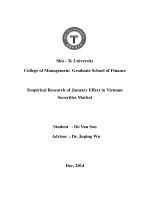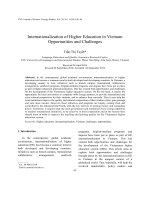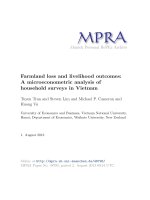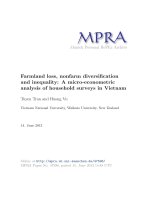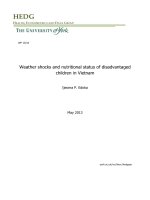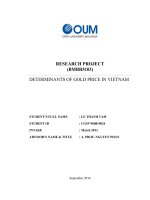CHARACTERISTICS OF MOISTURE TRANSPORT IN ENSO EVENTS IN VIETNAM
Bạn đang xem bản rút gọn của tài liệu. Xem và tải ngay bản đầy đủ của tài liệu tại đây (666.33 KB, 29 trang )
MINISTRY OF NATURAL RESOURCES AND ENVIRONMENT
VIETNAM INSTITUTE OF
METEOROLOGY, HYDROLOGY AND CLIMATE CHANGE
VU VAN THANG
CHARACTERISTICS OF MOISTURE TRANSPORT IN ENSO
EVENTS IN VIETNAM
Major: Meteorology and Climatology
Code : 62 44 02 22
ABSTRACT OF EARTH SCIENCES DISSERTATION
HA NOI-2016
The research is completed at:
VIETNAM INSTITUTE OF
METEOROLOGY, HYDROLOGY AND CLIMATE CHANGE
Supervisors:
1. Assoc. Prof. Dr. Nguyen Van Thang
2. Prof. Dr. Nguyen Trong Hieu
Reviewer 1:………………………………………………
Reviewer 2:………………………………………………
Reviewer 3:………………………………………………
The thesis will be submitted to National Scientific Council at:
Vietnam institute of Meteorology, Hydrology and Climate Change
At………..on…………………………
Thesis can be found at some libraries:………………………
PREFACE
1. Rationale
Located in the Asian monsoon region, the climate of Vietnam is
strongly influenced by the monsoon circulation and the ENSO
events. Below-average annual rainfall was observed over Vietnam in
El Niño years, due to the strengthen convection in the Eastern
Pacific. Whereas, the westward-moving of this convection in La
Niña years caused much more rainfall over Vietnam than average. It
is indicated that the moisture transport plays an important role in
tropical monsoon
circulation mechanism as well as affects the
weather and climate in Vietnam, especially extreme event such as
drought
and
heavy
rain.
Therefore,
this
research
titled
“Characteristics of moisture transport in the ENSO events in
Vietnam” is essential.
2. Objectives of research
1) To explore mechanism of the seasonal moisture transport in
Vietnam.
2) To determine the relationship between the moisture transport
and the ENSO event, especially in ENSO years which heavy rainfall
or severe drought occurred in Vietnam.
3) To propose the application of the moisture transport
information for monitoring droughts (during El Niño) and heavy
rainfall (during La Niña) over Vietnam.
3. Objects and research area
- Objects of research
+ Moisture transport: Total moisture transport, zonal and
meridional moisture transport.
+ Circulation component: Zonal and meridional winds, sea
level pressure.
+ The climatic elements and extreme events includes:
observed monthly rainfall from meteorological stations in Vietnam,
the grid reanalysis data of precipitation, the number of month with
drought, the number of month with heavy rainfall.
- Research area
+ Characteristics of moisture transport are evaluated over a
region of the Eastern Asia - Western Pacific (40°S-60°N, 40°E60°W), so called DATTBD (abbreviation in Vietnamese).
+ The circulation and sea level pressure are analysed over
the Eastern Asian region (10°S-40°N, 60°E-160°E).
+ The characteristics of climate, the number of drought
months and the number of heavy rainfall months are assessed over
all climatic regions of Vietnam.
4. The new finding of the research
1) This research determined the moisture source and the
moisture distribution in both normal and ENSO condition.
2) This research specified the relationship between the moisture
transport and droughts, heavy rain over climatic regions of Vietnam
during ENSO events.
3) This research also primarily explained the physical
mechanisms for evaluating the relationship between the moisture
transport and the autumn rainfall in the Central Vietnam during
ENSO period; and the rainfall in May in the Central Highlands
during El Niño events.
5. Perspective of the research
1) There are differences in the distribution of the moisture
transport between the normal condition and the ENSO condition.
2) There is a relationship between the moisture transport and
droughts, heavy rainfall over all climatic regions of Vietnam during
ENSO events.
3) The moisture transport is highly correlated to the autumn
rainfall in the Central Vietnam during ENSO condition and the
precipitation in May in the Central Highlands during El Niño
condition.
6. Scientific and practical signification
- The thesis represented the mechanism of the moisture transport
at annual and seasonal scale in Vietnam during normal condition and
ENSO condition.
- The thesis determined the relationship between the moisture
transport and heavy rain during La Niña events, and droughts during
El Niño events in Vietnam.
- The thesis initially explained the physical mechanism which
caused the decrease of rainfall in autumn over the Central Vietnam
during El Niño conditions, and the increase of rainfall during La
Niña conditions.
- The results of this dissertation can be used as reference for
further study of the relationship between the moisture transport and
rainfall, droughts during ENSO events. In addition, these results are
also useful for climate prediction which using the moisture transport
information for drought assessment during El Niño conditions and
heavy rain during La Niña conditions.
7. The structure of the thesis
Chapter 1: Literature reviews
Chapter 2: Data and Methodology
Chapter 3: Distribution of moisture transport under ENSO
conditions.
Chapter 4: The relationship between moisture transport and
droughts, heavy rain and rain over some regions of Vietnam during
ENSO.
Chapter 1: Literature reviews
1.1. Overview of moisture transport
From the mid-1980s, with the advanced improvement in
observation technology and the rapid development of computer
science, the moisture transport was thoroughly researched all over
the world which certainly contributed to the study of atmospheric
circulation and climate prediction.Various researches have been
conducted with the diversity of the reasearch objects, in different
regions and countries which evaluated some aspects of the moisture
transport includes:
- The spatial distribution of moisture transport: Zonal,
meridional and systhesized transport over various regions, the major
moisture transport over the continents.
- The temporal development of
the moisture transport over
regions (includes monsoon region).
- The relationship between the amount of moisture transport and
precipitation, especially with the extreme events such as drought,
heavy rainfall over many countries: India in South Asia, China in the
East Asia, Canada in the North America, South America, Australia
and other continents.
- The moisture balance or the moisture transport crossing the
boundaries: Western, Eastern, Southern, Northern borders of many
areas in South Asia, East Asia and some regions in North America.
In Vietnam, in recent years, many climatic researches have been
interested in this important atmospheric circulation element: The
atmospheric moisture transport and the relationship between the
moisture transport and monsoon as well as rainfall in some areas
over Vietnam. The results indicated that the moisture transport is
highly correlated to rainfall in the summer in the Northern and
Southern of Vietnam [4], [5], [20].
1.2. Overview of ENSO and its impacts on weather and climate
In recent years, with the advances of coupled atmosphere-ocean
model, the development of computer technology over the world,
many researches on ENSO events have been conducted including
about the physical mechanisms and the operation of ENSO, the
indices, characteristics in spatial and temporal distribution of ENSO,
the impact of ENSO to the circulation, monsoon, weather, climate
and extreme events .
1.3. Chapter summary
In Vietnam, the researches on moisture transport have been
carried out since the 2000s in some regions. The monthly spatial
moisture transport and the relationship between transport moisture
and summer rainfall in the North and South of Vietnam were
mentioned. So far, there is not any study or analysis on the seasonal
moisture transport mechanism over Vietnam, particularly moisture
transport under the ENSO conditions, the relationship between
moisture transport and droughts, heavy rain in Vietnam. It is similar
to the study about the ENSO events which were started from the
1990s, their principal research objects are the fundamental
knowledge of ENSO and the impacts of ENSO to atmospheric
circulation, monsoon, weather and climate. Therefore, it is necessary
to have further analysis of the following issues:- The spatial
distribution of seasonal total moisture transport in the atmospheric
layers and in the whole atmospheric column in normal condition and
under the ENSO condition.- The relationship between moisture
transport and droughts as well as heavy rainfall during ENSO events.
- In association with the circulation, the moisture and moisture
transport have significant impact on rainfall. It is necessary for a
deeper investigation for some particular regions such as the Central
Vietnam or the Central Highlands.
Chapter 2: Data and Methodology
2.1. Methodology
2.1.1. Atmospheric moisture transport calculation method
The moisture transport characteristics were calculated including
total moisture transport, zonal and meridional moisture transport
over the entire atmospheric column (1000 - 300 hPa) and on 3 layers
of atmosphere (1000-700 hPa, 700-500 hPa and 500-300 hPa).
1) Moisture transport vector on the whole atmospheric column from
the surface (Ps=1000 hPa) to 300 hPa level is calculated following
the formula below: [42, 44]:
300
1
Q (V q)dp
g 1000
(1)
2) Zonal moisture transport (Qu, kg m-1s-1) in the whole atmospheric
column from the surface (1000 hPa) to 300 hPa level is calculated
following the formula below:
1
300
𝑄𝑢 = − 𝑔 ∫1000(𝑢𝑞)𝑑𝑝
(2)
3) Meridional moisture transport (Qv, kg m-1s-1) over the whole
atmospheric column from the surface (1000 hPa) to 300 hPa level is
calculated following the formula below:
1
300
𝑄𝑣 = − ∫1000(𝑣𝑞)𝑑𝑝
𝑔
(3)
4) Total moisture transport in the whole atmospheric column (Q, kg
m-1 s-1) is calculated by the formula:
𝑄 = √𝑄𝑢2 + 𝑄𝑣2
(4)
Where: g- gravitational acceleration (m s-2); V- wind vector; uzonal wind speed (m s-1) and v- meridional wind speed (m s-1); q
special humidity (g kg-1); ps-pressure surface (1000 hPa).
5) Zonal moisture transport in the atmospheric layer from P1 to P2 is
calculated by the formula:
1
𝑝
𝑄𝑢 (𝑝1 , 𝑝2 ) = − 𝑔 ∫𝑝 2 𝑢(𝑝)𝑝(𝑝)𝑑𝑝
1
(5)
6) Meridional moisture transport on the atmospheric layer from
P1 to P2 is calculated by the formula:
1
𝑝
𝑄𝑣 (𝑝1 , 𝑝2 ) = − ∫𝑝 2 𝑣(𝑝)𝑝(𝑝)𝑑𝑝
𝑔
1
(6)
7) Total moisture transport on P1 to P2 atmospheric layers
𝑄 = √𝑄𝑢2 + 𝑄𝑣2
(7)
In this dissertation, total moisture transport in the entire
atmospheric column is calculated using zonal moisture transport
(Qu) and meridional moisture transport (Qv) by the continuous
integral approximation method with the trapezoidal rule for each
layer of the atmosphere, separated by standard isobaric surface 1000,
925, 850, 700, 600, 500, 400, 300hPa. Resultant moisture transport
over 3 atmospheric layers: 1) 1000 -700hPa (P1 = 1000 hPa, P2 = 700
hPa); 2) 700-500hPa (P1 = 700 hPa, P2 = 500 hPa) and 3) 500-300
hPa (P1 = 500 hPa, P2 = 300 hPa) is calculated by the zonal and
meridional component on the atmospheric layers with the same
method as for the whole atmospheric column.
Moisture transport was calculated on 2,5º x 2,5º grid for
DATTBD (400S-600N, 400E-600W), for Vietnam and the surrounding
regions. Besides, in some cases, moisture transport is calculated for
East Asia region which limitted in 100S- 400N, 600E-1600E.
2.1.2. Moisture transport crossing 4 boundaries over all the
climatic regions in Viet Nam.
Monthly moisture transport on the whole atmospheric column in
the period 1960-2009 through the boundary of 3 regions in Vietnam
including (1) Northern region of Vietnam (BBVN ) located in 20 0N240N 1020E-1100E; (2) Central region of Vietnam (TBVN) located in
140N-200N, 1020E-1100E and (3) Southern region of Vietnam
(NBVN) located in 80N-140N, 1020E-1100E.
2.1.3. Method of identifying the ENSO events
ENSO events are determined according to [4] the following
criteria:
A La Niña occurs when there are at least six consecutive months
with three month running mean of the SSTA over NINO 3.4 region is
less than or equal to -0,50C.
An El Niño occurs when there are at least six consecutive
months with three month running mean of the SSTA over NINO 3.4
region is greater than or equal to 0,50C.
Based on the above criteria, there were 13 El Niño events (109
El Niño months) and 11 La Niña events (168 La Niña months)
during period 1960 – 2009.
2.1.4. Determination of heavy rain months and drought months
2.1.4.1 Determining heavy rain months
Over all climatic regions of Vietnam, the month with total rainfall is
greater than or equal 450 mm is defined as heavy rain month.
2.1.4.2 Determining drought months
The drought month is the month with total rainfall (Rth) is less
than or equal a threshold (R). This threshold is defined as:
For November, December, Januarry, February: R = 10 mm;For
March, April, September, October: R = 30 mm;For other months: R
= 80 mm.
2.1.5. The relationship between moisture transport and heavy rain,
droughts
The relationships between moisture transport and the number of
droughts months, the number of heavy rain months over Vietnam
climatic regions are analyzed based on the correlation coefficient
(rxy) between 2 two variables x and y:
𝑟𝑥𝑦 =
∑𝑡(𝑥𝑡 −𝑥̅ )(𝑦𝑡 −𝑦̅)
1
[∑𝑡(𝑥𝑡 −𝑥̅ )2 ∑𝑡(𝑦𝑡 −𝑦̅)2 ]2
(8)
Where: x- zonal moisture transport, meridional moisture
transport; y- The number of drought or heavy rain month of 7
climatic regions of Vietnam
2.2. Data
- The station data: Using monthly rainfall data of 56
meteorological stations in the period 1960-2009 over 7 climatic
regions of Vietnam.
- The data of circulation: specific humidity, zonal and meridional
wind on isobaric surface levels 1000-300hPa with the resolution of
2,5°x2,5°.
- The wind field from Reanalysis dataset CFSR at 10m, 850hPa;
mean sea level pressure with the resolution of 0,5°x0,5° in the period
1980-2007 from NCEP dataset.
- The APHRODITE rainfall dataset on the grid with the
resolution of 0,250x0,250.
Chapter 3: Distribution of moisture transport
under ENSO conditions
3.1 Total moisture transport in ENSO condition.
3.1.1 Total moisture transport in normal conditions.
The South-western moisture transport has magnitude of 150-180
kgm-1s-1 on the entire atmospheric column, in which 60-70 kgm-1s-1
on layer 1, 58-68 kgm-1s-1 on layer 2 and 33-43 kgm-1s-1 on layer 3.
The amount of North-eastern moisture transport is 210-240 kgm1 -1
s in the entire atmospheric column, in which 90-100 kgm-1s-1 on
layer 1, 75-85 kgm-1s-1 on layer 2 and 45 - 55 kgm-1s-1 on layer 3.
The South-eastern moisture transport has magnitude of 170-200
kgm-1s-1 in the whole atmospheric column, in which 110-120 kgm-1s1
on layer 1, 50-60 kgm-1s-1 on layer 2 and only 10-20 kgm-1s-1 on
layer 3.
Thus, in annual scale, the moisture transport intensity is
strongest in North-eastern zone, and then the South-eastern and the
weakest is the South-western zone. The moisture transport decreases
from layer 1 to layer 2 and from layer 2 to layer 3.
Total moisture transport always changes in the direction and
intensity each season.
In the North of Vietnam, the western and southwestern moisture
transport is 75-90 kgm-1s-1 in the whole atmospheric column, in
which 33-38 kgm-1s-1 on layer 1, 28-33 kgm-1s-1 on layer 2 and 15-20
kgm-1s-1 on layer 3.Over the Central of Vietnam, Eastern and Northeastern moisture transport is 45-60 kgm-1s-1 in the whole atmospheric
column, in which 25-30 kgm-1s-1 on layer 1, 10-15 kgm-1s-1 on layer
2 and on layer 3.
In the South of Vietnam, eastern and northeastern moisture
transport is 45-60 kgm-1s-1 in the whole atmospheric column, in
which 20-15 kgm-1s-1 on layer 1, 15-20 kgm-1s-1 on layer 2 and 10-15
kgm-1s-1 layer 3.
For the whole year, moisture transport has direction of west and
southwest in the North of Vietnam and direction of East and
Northeast in the Central and the South of Vietnam. Moisture
transport has the strongest intensity in the summer and the weakest
intensity in the winter and the spring over Vietnam.
In the whole atmospheric column, moisture transport in Northern
Vietnam is stronger than in the Central and Southern Vietnam. In the
atmospheric layers, moisture transport is strongest in layer 1 and
weakest in layer 3.
3.1.2. Total moisture transport in El Niño conditions
Over DATTBD region, South-western moisture transport has
average value of 180-210 kgm-1s-1 in the whole atmospheric
column, in which 70-80 kgm-1s-1 on layer 1, layer 2 and 40-50 kgm1 -1
s on layer 3; North-eastern moisture transport zone has the mean
value of 190-220 kgm-1s-1 in the whole the atmospheric column, in
which, 90-100 kgm-1s-1 on layer 1, 60-70 kgm-1s-1 on layer 2 and 4050 kgm-1s-1 on layer 3; Southeastern moisture transport zone has the
average value of 140-170 kgm-1s-1 throughout the atmospheric
column, in which, 90-100 kgm-1s-1 on layer 1, 30-40 kgm-1s-1 on layer
2 and 20-30 kgm-1s-1 on layer 3. In Vietnam, on the northern region,
direction of total moisture transport is west and southwest with the
mean value of 90-120 kgm-1s-1 in the whole atmospheric column, in
which 50-60 kgm-1s-1 on layer 1, 20-30 kgm-1s-1 on layer 2 and 20-30
kgm-1s-1 on layer 3. On the central area, eastern and northeastern
total moisture transport is 20-50 kgm-1s-1 in the whole atmospheric
column, in which 10-20 kgm-1s-1 on layer 1, layer 2 and 0-10 kgm-1s-1
on layer 3. On the Southern region, eastern and northeastern total
moisture transport is 30-60 kgm-1s-1 throughout the atmospheric
column, in which 10-20 kgm-1s-1 on each layer.
3.1.3 Total moisture transport in La Niña conditions
Over DATTBD region, the South-western moisture transport
zone has average value of 140-170 kgm-1s-1 in the whole atmospheric
column, in which 60-70 kgm-1s-1 on layer 1, 50-60 on the layer 2 and
30-44 kgm-1s-1 on layer 3; the North-eastern moisture transport zone
has the mean value of 240-270 kgm-1s-1 in the whole the atmospheric
column, in which, 120-130 kgm-1s-1 on layer 1, 70-80 kgm-1s-1 on
layer 2 and 50-60 kgm-1s-1 on layer 3; average value of Southeastern
moisture transport zone is 140-170 kgmm-1s-1 in the whole
atmospheric column, in which, 90-100 kgm-1s-1 on layer 1, 40-50
kgm-1s-1 on layer 2 and 10-20 kgm-1s-1 on layer 3.
In Vietnam, the characteristic of total moisture transport in 11 La
Niña events are: In the northern area, total moisture transport has
direction of west and southwest with the average value of 50-80
kgm-1s-1 in the whole atmospheric column, in which 20-30 kgm-1s-1
on layer 1, layer 2 and 10-20 kgm-1s-1 on layer 3; On the central of
Vietnam, direction of total moisture transport is east and northeast
with the mean intensity of 50 -80 kgm-1s-1 in the whole atmospheric
column, in which 30-40 kgm-1s-1 on layer 1 and 10-20 kgm-1s-1 on
layer 2 and layer 3; On the Southern region, total moisture transport
has direction of east and northeast with the average value of 70-100
kgm-1s-1 in the whole atmospheric column, in which 30-60 kgm-1s-1
on layer 1, 20-30 kgm-1s-1 on layer 2 and on layer 3.
3.2. Total moisture transport in each ENSO event
3.2.1. Total moisture transport in the entire atmospheric column in
each of El Niño events
Over the DATTBD region, the intensity of each moisture
transport zone (Southwest, Northeast, Southeast) are very different in
El Niño events. However, in general, they varied around the mean
intensity of 13 El Niño events.
Dominant direction of moisture transport in each region (North,
Central, South) in El Niño events is the mean direction of moisture
transport in 13 El Niño events.
Based on the direction of moisture transport over Vietnam, the El
Niño events can be divided into 3 categories:
Category 1: Moisture transport has direction of north-east in the
Northern and South-western in the Central and the South of
Vietnam;Category 2: Moisture transport has south-western direction
in all over 3 regions: North, Central and South;Category 3: Moisture
transport has direction of northeast in all three regions: North,
Central and South.
3.2.2. Total transport in the entire atmospheric column in each La
Niña event.
Intensity of each moisture transport zones (Southwest, Northeast,
Southeast) are very different among La Niña events, however, in
general, they varied around the mean intensity of 11 La Niña
events.Dominant direction of moisture transport in each region
(North, Central, and South) during La Niña is the mean direction of
the moisture transport in 11 La Niña events.
Under La Niña conditions, the north-eastern moisture transport is
enhanced. Besides, 2 La Niña - type 3 events with North-eastern
moisture transport over all 3 regions occur.
Chapter 4: The relationship between moisture transport and
droughts, heavy rain and rain over some region in Vietnam
under ENSO conditions
4.1. Moisture transport crossing the boundaries over some
regions in Vietnam
On the northern area, moisture source provided for rainy season
in BBVN in the early and middle of summer (V-VIII) is mainly from
the west and south, in the end summer (IX, X) is from the east.
On the central of Vietnam, moisture resource provided for rainy
months including IX, X, XI is mainly from the East Sea through the
eastern boundary.
On the Southern region, moisture source provided for rainy
season in the early and mid summer is mainly through the western
and southern boundary and mainly through the eastern boundary in
the end of summer.
4.2. The relationship between moisture transport and droughts
under El Niño condition in Vietnam
4.2.1. The effects of El Niño on droughts in Vietnam
Impacts of El Niño on droughts in Vietnam is considered by
analysis the sign of anomaly drought index over 7 climate regions in
13 El Niño events in the period 1960 - 2009. The analysis results
indicate that El Niño contribute to the increase in droughts. However,
the impacts of El Niño on droughts are very different between the
North and the South. Its impact is very significant in the south of
Vietnam meanwhile it is quite weak in the North, except the North
Central region.
4.2.2. The relationship between moisture transport and droughts in
Vietnam
The relationship between moisture transport and the number of
droughts months under El Niño events is considered by using
correlation coefficient between zonal, meridional moisture transport
and the number of droughts months (STH) over 7 areas including:
BBVN, TBVN, NBVN, TGTQ, XĐ-ĐNA, BĐ in 13 El Niño events.
The correlation between STH and Qu and QV is quite weak over
5 climatic regions including TB, DB, DBBB, TN and NB. In
contrast, the correlation coefficient between STH over the BTB,
NTB and Qu, QV is remarkable.
4.3. The relationship between moisture transport and heavy rain
in La Niña events in Vietnam
4.3.1. Effects of La Niña on heavy rains in Vietnam
According to the calculations of the capability of occurring
heavy rain under normal conditions and La Niña conditions, it is
indicated that heavy rainfall occurs in 4/7 climatic regions and 33/56
stations under La Nina condition.
4.3.2. The relationship between moisture transport and heavy rain
in Vietnam
The relationship between moisture transport and the number of
heavy rainfall months under La Nina events is considered by using
correlation coefficient between zonal, meridional moisture transport
and the number of heavy rainfall months (STML) over 7 climatic
regions in 11 La Niña events.
The results show that most correlation coefficients between
STML on 7 climatic regions of Vietnam and Qu is positive. The
correlation is quite high on TB, ĐB regions, moderate on BTB, NTB
regions and quite low on DBBB, TN, NB regions. Most correlation
coefficient between STML and QV is positive. It is quite high on the
TB, NE regions, moderate on the BTB, NTB, TN and relatively low
on DBBB, NB regions.
4.4. Applying the moisture transport information to research the
influence of ENSO on rainfall over specific area
The effects of ENSO on rainfall in the Central of Vietnam are
conducted by using rainfall observation from 13 coastal stations
(120N-190N) and Aphrodite data in the period 1980-2007.
The ENSO autumns are determined based on Oceanic Nino
index over the Nino3.4 region (ONI) of NOAA. In the period 19802007, there were 9 El Niño and 10 La Niña autumns [35].
4.4.1. Effects of ENSO on rainfall in Central of Vietnam in the
autumn, the role of moisture transport
4.4.1.1. Distribution of total rainfall in the autumn over Central of
Vietnam
Total rainfall in the autumn (IX, X, XI) in the Central of Vietnam
ranges from 800 to 2400mm. There are four heavy rainfall center
whose total rainfall are over 1600 mm including: Ky Anh (1740mm),
Hue (1887mm), Tra My (2429mm) and Ba To (2094mm).
4.4.1.2. Effects of El Niño
Under the El Niño conditions, total rainfall autumn in the Central
of Vietnam decrease from -15 to -25%. The highest decrease is 30.3% (Nha Trang), the lowest is -3.9% (Dong Ha ) and the average
is 18.3%.
The confidence level of the dependence of decrease in autumn
rainfall on El Niño condition is verified by t-Test in which rainfall
data of 9 El Niño autumn and 9 autumn in normal condition are
employed to compare with climatology. The results are indicated that
the difference of rainfall in El Niño and climatology has the
confidence of 95%.
The decrease in autumn rainfall over the Central of Vietnam in
the El Niño conditions relates to the formation of an anticyclonic
wind anomaly vector over the East Sea. This anticyclonic formed
due to the North East monsoon is weaker than the climatology
leading to the shortage of moisture source from the Pacific to the
East Sea and the Central of Vietnam.
4.4.1.3. Effects of La Niña
The rainfall in autumn over the Central of Vietnam increase
around 10.1% under the influence of La Niña condition. The increase
in autumn rainfall in La Niña conditions due to the following
reasons: (1) North East monsoon at lever 10m and 850hPa are
stronger than climatology leading to the formation of a cyclonic
wind anomaly vector in the middle of East Sea. This cyclone
provides much more moisture for rainfall in the Central of Vietnam;
(2) There are 2 strengthen sources of moisture provided for rainfall
in the Central of Vietnam including a source from outside the Pacific
to the East Sea and another moisture source from lower latitudes.
The figure 4.1 illustrates the factors controlling the autumn
rainfall in the Central of Vietnam during ENSO conditions. The
differences between El Niño and La Niña are: (1) the North East
monsoon is weaker during El Niño conditions compared to La Niña
conditions; (2) the secondary moisture source over the southern
region of the East Sea is absent during in El Niño conditions (Figure
4.1a) and (3) Under El Niño conditions, there is an anticyclonic wind
anomaly over the East Sea, meanwhile there is a cyclonic wind
anomaly there during La Niña (Figure 4.1b).
Fig. 4.1. Schematic diagrams of atmospheric circulations for (a) El
Niño, and (b) La Niña conditions. Wind flows are indicated by thick
dark arrows. Wind anomalies are indicated by gray arrows.
4.4.2. Effects of El Niño on the decrease in rainfall in May over
Central Highlands, the role of moisture transport
Under the impacts of El Niño, the total rainfall in May over the
Central Highlands region decrease in almost stations (11/12
Stations). The decrease ranges from 10 to 25%. The highest decrease
value is 30.9% (Buon Ho) and the lowest is 3.1% (A Yun Pa), except
Lien Khuong station where rainfall increases 10%.
The reduction of rainfall in May in the Central Highlands during
El Niño conditions is related to a cyclonic wind anomaly over the
Bay of Bengal. This cyclone appears due to the weakening of the
southwest monsoon circulation compared to the average of many
years. In addition, the large moisture source providing for rain of the
Central Highlands in the south of the Bay of Bengal is lower than the
average of many years.
Conclusions and recommendations
1. Conclusions
According to the results of
the research on the moisture
transport characteristics over the DATTBD region and Vietnam as
well as the relationship between the moisture transport and rainfall,
heavy rain and droughts in Vietnam during the ENSO, it can be
concluded as follows:
1) For the moisture transport over DATTBD region and Vietnam
during normal conditions
- There are always three main moisture transport zones with
different values between seasons in the DATTBD region including
(1) the South-western moisture transport zone in the middle latitude
regions; (2) the North-eastern moisture transport zone in tropicalequatorial-western Pacific; (3) the South-eastern moisture transport
zone in the southern hemisphere. Annually, total moisture transport is
strongest in the Northeastern zone and weaker in the Southeastern
zone and weakest in the southwestern zone. The moisture transport
also decreases gradually from layer 1 to 2 and from 2 to layer 3.
- In Vietnam, the direction of moisture transport in the winter
and spring is West and Southwest in the North. Its direction in the
Central and the South is East and Northeast. In the summer, the
direction of moisture transport is West and Southwest in all regions
over Vietnam; in contrast, in the autumn the direction is East and
Northeast. Annually, the direction of moisture transport in the North
of Vietnam is Southwest and its direction in the Central and the
South of Vietnam is East and Northeast. The intensity of moisture
transport is strongest in the summer and weakest in the winter or
spring. On the entire atmospheric column, in annual scale, the
intensity of moisture transport in the North of Vietnam is stronger
than in the Central and South of Vietnam. In the atmospheric layers,
moisture transport is strongest in layer 1 and weakest in layer 3.
2) For the moisture transport in DATTBD and Vietnam during
ENSO conditions.
- Over the DATTBD region, during El Niño conditions,
Southwestern moisture transport zone is enhanced while both Northeastern and South-eastern moisture transport zone is weaker. In
contrast, during La Niña conditions, the South-western moisture
transport zone is weaker while Northeastern zone is stronger.
- In Vietnam, during El Niño conditions, Western and
Southwestern moisture transport in the north of Vietnam is enhanced
while the intensity of Eastern and Northeastern moisture transport in
the Central and the South decreases. In contrast, under La Niña
conditions, the intensity of Western and Southwestern moisture
transport in the north declines whereas the intensity of Eastern and
Northeastern moisture transport in the Central and the South
increases.
